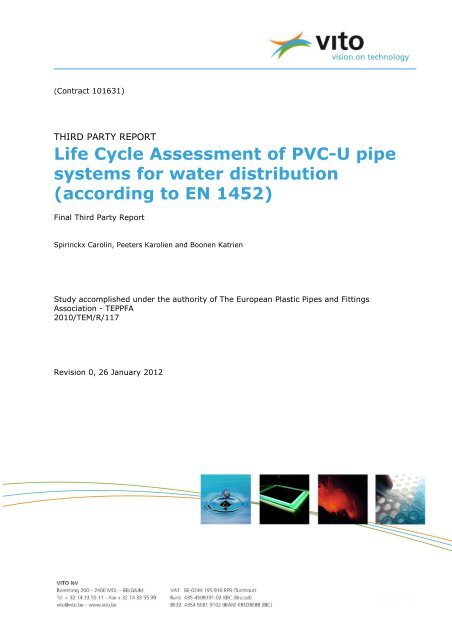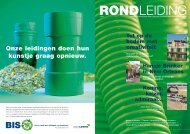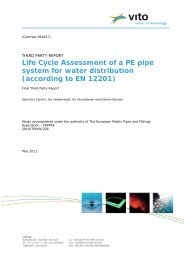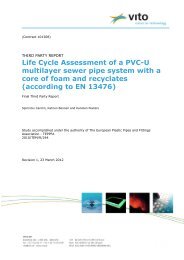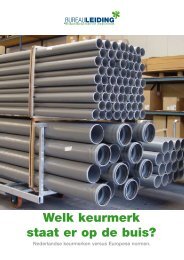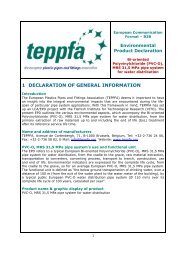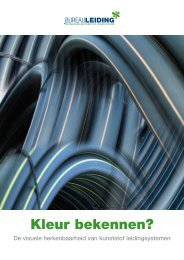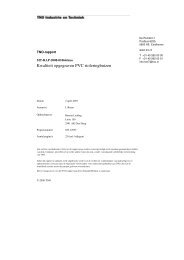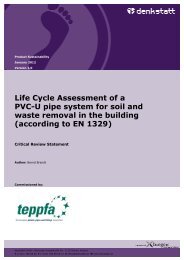Life Cycle Assessment of PVC-U pipe systems for ... - BureauLeiding
Life Cycle Assessment of PVC-U pipe systems for ... - BureauLeiding
Life Cycle Assessment of PVC-U pipe systems for ... - BureauLeiding
Create successful ePaper yourself
Turn your PDF publications into a flip-book with our unique Google optimized e-Paper software.
(Contract 101631)<br />
THIRD PARTY REPORT<br />
<strong>Life</strong> <strong>Cycle</strong> <strong>Assessment</strong> <strong>of</strong> <strong>PVC</strong>-U <strong>pipe</strong><br />
<strong>systems</strong> <strong>for</strong> water distribution<br />
(according to EN 1452)<br />
Final Third Party Report<br />
Spirinckx Carolin, Peeters Karolien and Boonen Katrien<br />
Study accomplished under the authority <strong>of</strong> The European Plastic Pipes and Fittings<br />
Association - TEPPFA<br />
2010/TEM/R/117<br />
Revision 0, 26 January 2012
All rights, amongst which the copyright, on the materials described in this document rest with the European Plastics<br />
Pipes and Fittings Association (“TEPPFA”), Avenue de Cortenbergh, 71, B-1000 Brussels (Belgium).<br />
The in<strong>for</strong>mation provided in this document is confidential in<strong>for</strong>mation <strong>of</strong> TEPPFA. This document may not be reproduced<br />
or brought into circulation without the prior written consent <strong>of</strong> TEPPFA. Without prior permission in writing from TEPPFA<br />
this document may not be used, in whole or in part, <strong>for</strong> the lodging <strong>of</strong> claims, <strong>for</strong> conducting proceedings, <strong>for</strong> publicity<br />
and/or <strong>for</strong> the benefit or acquisition in a more general sense.
Table <strong>of</strong> Contents<br />
TABLE OF CONTENTS<br />
Table <strong>of</strong> Contents ___________________________________________________________________ I<br />
Chapter 1 Introduction _____________________________________________________________ 1<br />
Chapter 2 Goal and scope definition _______________________________________________ 3<br />
2.1 Definition <strong>of</strong> goal <strong>of</strong> the study _____________________________________ 3<br />
2.2 Definition <strong>of</strong> scope <strong>of</strong> the study ____________________________________ 3<br />
Chapter 3 <strong>Life</strong> cycle inventory _____________________________________________________ 7<br />
3.1 Data requirements ______________________________________________ 7<br />
3.2 Data collection procedures ________________________________________ 8<br />
Chapter 4 <strong>Life</strong> cycle impact assessment __________________________________________ 11<br />
4.1 Method ______________________________________________________ 11<br />
4.2 The environmental pr<strong>of</strong>ile <strong>of</strong> the <strong>PVC</strong>-U (MRS 25 MPa) pressure <strong>pipe</strong> system <strong>for</strong><br />
water distribution ___________________________________________________ 12<br />
Chapter 5 Final conclusions _______________________________________________________ 15<br />
Chapter 6 Critical review statement ______________________________________________ 17<br />
6.1 Introduction __________________________________________________ 17<br />
6.2 Review Process ________________________________________________ 17<br />
6.3 Scientific Background ___________________________________________ 18<br />
6.4 Critical Review Findings _________________________________________ 18<br />
6.5 Conclusion ___________________________________________________ 19<br />
6.6 References ___________________________________________________ 19<br />
List <strong>of</strong> references__________________________________________________________________ 21<br />
I
Chapter 1 Introduction<br />
CHAPTER 1<br />
INTRODUCTION<br />
The European Plastics Pipes and Fittings Association (TEPPFA) deems it important to<br />
have an insight into the integral environmental burdens encountered during the lifespan<br />
<strong>of</strong> particular <strong>pipe</strong> system applications. With this framework in mind, TEPPFA has<br />
set up a project with the Flemish Institute <strong>for</strong> Technological Research (VITO). The aim<br />
<strong>of</strong> the first TEPPFA project frame was to carry out a life cycle assessment (LCA) from<br />
cradle to grave <strong>of</strong> different specific applications <strong>of</strong> plastic <strong>pipe</strong> <strong>systems</strong>. One <strong>of</strong> the<br />
<strong>systems</strong> studied in the first phase <strong>of</strong> the project was the PE <strong>pipe</strong> system <strong>for</strong> water<br />
distribution (pressure). This report presents the results <strong>of</strong> the LCA <strong>of</strong> another type <strong>of</strong><br />
water distribution system, more specifically the <strong>PVC</strong>-U (MRS 25 MPa) pressure <strong>pipe</strong><br />
system <strong>for</strong> water distribution.<br />
The Flemish Institute <strong>for</strong> technological Research (VITO) has analysed the various<br />
environmental aspects, which accompany this pressure <strong>pipe</strong> system, from the primary<br />
extraction <strong>of</strong> raw materials up to and including the end <strong>of</strong> life (EoL) treatment after the<br />
<strong>pipe</strong>’s reference service life time are analysed by means <strong>of</strong> an LCA assessment. The<br />
final aim <strong>of</strong> the study is to establish an environmental product declaration (EPD). The<br />
EPD has been made according to the CEN framework (CEN TC 350 draft framework<br />
documents, 2008 - 2009).<br />
This document is a summary <strong>of</strong> the LCA study <strong>of</strong> the <strong>PVC</strong>-U <strong>pipe</strong> system <strong>for</strong> water<br />
distribution (according to EN 1452) and serves as a ‘Third Party Report’ which is aimed<br />
at a broad public. TEPPFA can also use the results <strong>of</strong> this LCA study <strong>for</strong> the following<br />
purposes:<br />
• to support policy concerning sustainable construction;<br />
• to anticipate future legislation regarding environment and certification (product<br />
development);<br />
• <strong>for</strong> communication with various stakeholders;<br />
• to apply <strong>for</strong> an EPD (Environmental Product Declaration), as described in ISO TR<br />
14025 (ISO, 2006) and in the CEN documents (CEN TC 350 draft framework<br />
documents, 2008 – 2009);<br />
• to focus improvement activities on the most important impact-generating process<br />
phases;<br />
• to consider new product developments;<br />
• ...<br />
VITO is the author <strong>of</strong> this comprehensive LCA study which has been carried out under<br />
assignment from TEPPFA. The study started early in 2011 and was completed in<br />
December 2011. The LCA study has been critically reviewed by denkstatt (see Chapter<br />
6).<br />
The methodology used to determine the environmental aspects <strong>of</strong> the <strong>PVC</strong>-U <strong>pipe</strong><br />
system <strong>for</strong> water distribution is con<strong>for</strong>m to the LCA methodology, as prescribed in ISO<br />
standards 14040 and 14044 (ISO, 2006). According to these ISO standards, an LCA is<br />
carried out in 4 phases:<br />
1. Goal and scope definition <strong>of</strong> the study;<br />
2. <strong>Life</strong> cycle data inventory (LCI);<br />
1
Chapter 1 Introduction<br />
3. Determining the environmental impacts by means <strong>of</strong> a life cycle impact<br />
assessment (LCIA);<br />
4. Interpretation.<br />
For this project the different environmental impact categories presented in the draft<br />
documents prepared within the technical committee CEN TC 350 “Sustainability <strong>of</strong><br />
construction works” are used (CEN TC 350 draft framework documents, 2008 – 2009).<br />
An overview <strong>of</strong> these categories can be found in the clean version <strong>of</strong> the prEN15804<br />
(Sustainability <strong>of</strong> construction works – Environmental Product Declarations – Core rules<br />
<strong>for</strong> the product category <strong>of</strong> construction products).<br />
The design <strong>of</strong> this third-party report complies with these 4 phases <strong>of</strong> the LCA, whereby<br />
the various chapters describe each phase <strong>of</strong> the LCA. All relevant ISO guidelines were<br />
implemented when compiling this ‘Third Party Report’ (ISO 14044, paragraph 5.2).<br />
2
Chapter 2 Goal and scope definition<br />
CHAPTER 2<br />
GOAL AND SCOPE DEFINITION<br />
2.1 Definition <strong>of</strong> goal <strong>of</strong> the study<br />
TEPPFA wants a cradle to grave LCA consistent with ISO 14040 and ISO 14044 series <strong>of</strong><br />
standards to assess the environmental per<strong>for</strong>mance <strong>of</strong> TEPPFA plastic piping <strong>systems</strong>.<br />
This LCA-study aims to examine the <strong>PVC</strong>-U <strong>pipe</strong> system <strong>for</strong> water distribution<br />
(according to EN 1452), to gather and assess comprehensive and reliable in<strong>for</strong>mation<br />
regarding the environmental per<strong>for</strong>mance <strong>of</strong> these <strong>PVC</strong> pressure <strong>pipe</strong> system over their<br />
entire life cycle. In the same time, this study helps to provide a reliable database <strong>for</strong><br />
the development <strong>of</strong> an ISO 14025 Type III Environmental Product Declaration (EPD) on<br />
the European level <strong>for</strong> the <strong>PVC</strong> pressure <strong>pipe</strong> system. The CEN framework (TC 350 –<br />
Sustainability <strong>of</strong> Construction works) and more specifically the work per<strong>for</strong>med within<br />
the technical committee TC 350 (CEN TC 350 framework documents, 2008-2009) was<br />
used <strong>for</strong> this project.<br />
The intended audience <strong>of</strong> this LCA-study <strong>of</strong> the <strong>PVC</strong>-U <strong>pipe</strong> system <strong>for</strong> water<br />
distribution are the TEPPFA member companies and its National Associations in the first<br />
place and external stakeholders (like governments, pr<strong>of</strong>essionals, installers) at the<br />
second stage. TEPPFA expects to use the in<strong>for</strong>mation from this study in aggregated<br />
manner <strong>for</strong> public communications, to develop marketing materials <strong>for</strong> customers and<br />
to provide data to customers <strong>for</strong> the purpose <strong>of</strong> developing LCIs and EPDs within the<br />
building and construction sector.<br />
Since TEPPFA wishes to publicly communicate the results <strong>of</strong> the LCAs a critical review<br />
has been per<strong>for</strong>med by denkstatt and 3 rd party report has been compiled.<br />
2.2 Definition <strong>of</strong> scope <strong>of</strong> the study<br />
The scope <strong>of</strong> the study is defined in the functional unit. The functional unit is closely<br />
related to the function(s) fulfilled by the to-be-investigated product. The function <strong>of</strong> the<br />
<strong>PVC</strong>-U pressure <strong>pipe</strong> system <strong>for</strong> water distribution is to transport (supply) a certain<br />
amount <strong>of</strong> water from the exit <strong>of</strong> the water plant to the water meter <strong>of</strong> the building. In<br />
consultation with TEPPFA, its steering committee and the Application Group (AG)<br />
Utilities the definition <strong>of</strong> the function and the functional unit <strong>of</strong> the <strong>PVC</strong>-U pressure <strong>pipe</strong><br />
system <strong>for</strong> water distribution was discussed. The basic assumption was that the<br />
definition <strong>of</strong> the functional unit should represent the function <strong>of</strong> the <strong>PVC</strong> pressure <strong>pipe</strong><br />
system <strong>for</strong> water distribution over their entire life cycle: raw material extraction,<br />
material production, production <strong>of</strong> the <strong>pipe</strong>s and fittings, the construction phase, the<br />
use phase and the processing <strong>of</strong> the waste at the end <strong>of</strong> life <strong>of</strong> the <strong>PVC</strong> pressure <strong>pipe</strong><br />
system. The functional unit <strong>of</strong> the water distribution <strong>pipe</strong> system has been defined as:<br />
“the below ground transportation <strong>of</strong> drinking water, over a distance <strong>of</strong> 100 m (from the<br />
exit <strong>of</strong> the water plant to the water meter <strong>of</strong> the building), by a typical public European<br />
<strong>PVC</strong>-U <strong>pipe</strong> system <strong>for</strong> water distribution (Ø 110mm) over the complete life cycle <strong>of</strong><br />
100 years, calculated per year”.<br />
3
Chapter 2 Goal and scope definition<br />
In order to define the design <strong>of</strong> the <strong>PVC</strong> pressure <strong>pipe</strong> system <strong>for</strong> water distribution in<br />
terms <strong>of</strong> the functional unit the following considerations have been made:<br />
• Pipe material: dark grey unplasticized polyvinylchloride MRS 25 MPa – wall<br />
thickness: 4,2 mm - meter weight <strong>of</strong> <strong>pipe</strong>s: 2,112 kg;<br />
• Pipe diameter: ø 110 mm (as a representative <strong>for</strong> the average <strong>pipe</strong> diameter from<br />
the exit <strong>of</strong> the water plant to the water meter <strong>of</strong> the building);<br />
• 110 mm <strong>pipe</strong> calculated as average weight per metre calculated from actual sales<br />
across a market in sizes 20 mm to 1000 mm;<br />
• SDR 26;<br />
• Service life time <strong>of</strong> 100 years (Schulte and Hessel, 2006);<br />
• 2 types <strong>of</strong> fittings: <strong>PVC</strong> fittings and ductile iron fittings;<br />
• The popularity <strong>of</strong> fittings in “average” <strong>pipe</strong> <strong>of</strong> functional unit is calculated from<br />
actual sales data. The weight <strong>of</strong> fittings is calculated from company weight / piece<br />
data;<br />
• Galvanised steel <strong>for</strong> bolt, nut, washer and rings has been taken into consideration<br />
in the product system, as well as the cutter (which become part <strong>of</strong> the system) and<br />
EPDM gaskets;<br />
• Water use will include:<br />
o Agriculture – 42%;<br />
o Industry – 23%;<br />
o Urban – 18%;<br />
o Energy – 18%.<br />
• Activity area (typical): 6720 inhabitants;<br />
• Direct usage per person 150 l/day: 6,25 litre/hour;<br />
• Speed: 1,5 meter/second;<br />
• Hydraulic gradient <strong>of</strong> 1,65 m/100m;<br />
• Flow capacity <strong>of</strong> a 110 mm SDR 26, <strong>PVC</strong>-U <strong>pipe</strong> <strong>of</strong> average roughness at a flow<br />
speed <strong>of</strong> 1,5 m per second (EN 805 advises that “in practice it will be desirable to<br />
avoid unduly high or low velocities. The range 0,5 m/s to 2,0 m/s may be<br />
considered appropriate) were taken into account;<br />
• Most common components (other than <strong>pipe</strong>) used in functional unit:<br />
o Tapping Tee;<br />
o Coupler;<br />
o Flange (inc. nuts, bolts, washes and gaskets);<br />
o 45 elbow;<br />
o 90 elbow;<br />
o Retaining rig.<br />
The life cycle <strong>of</strong> the <strong>PVC</strong> pressure <strong>pipe</strong> system <strong>for</strong> water distribution has been divided in<br />
the following different life cycle phases:<br />
• Production <strong>of</strong> raw materials <strong>for</strong> <strong>PVC</strong>-U (MRS 25 MPa) <strong>pipe</strong>s;<br />
• Transport <strong>of</strong> <strong>PVC</strong> <strong>pipe</strong> raw materials to converter;<br />
• Converting process <strong>for</strong> <strong>PVC</strong>-U (MRS 25 MPa) <strong>pipe</strong> (extrusion);<br />
• Production raw materials <strong>for</strong> <strong>PVC</strong>-U fittings;<br />
• Transport <strong>of</strong> <strong>PVC</strong>-U fitting raw materials to converter;<br />
• Converting process <strong>for</strong> <strong>PVC</strong>-U fittings (injection moulding);<br />
• Production <strong>of</strong> ductile iron fittings (raw materials, transport and production process)<br />
being part <strong>of</strong> the <strong>PVC</strong>-U <strong>pipe</strong> system;<br />
• Production <strong>of</strong> galvanised steel components (raw materials + converting process)<br />
being part <strong>of</strong> the <strong>PVC</strong>-U <strong>pipe</strong> system;<br />
• Production <strong>of</strong> steel cutter, being part <strong>of</strong> the <strong>PVC</strong>-U <strong>pipe</strong> system;<br />
• Production <strong>of</strong> EPDM gaskets (raw materials + converting process), being part <strong>of</strong> the<br />
<strong>PVC</strong>-U <strong>pipe</strong> system;<br />
• Transport <strong>of</strong> complete <strong>PVC</strong> pressure <strong>pipe</strong> system to the trench;<br />
• Installation <strong>of</strong> complete <strong>PVC</strong> pressure <strong>pipe</strong> system at the trench;<br />
4
Chapter 2 Goal and scope definition<br />
• Use and maintenance <strong>of</strong> the complete <strong>PVC</strong> pressure <strong>pipe</strong> system during 100 years<br />
<strong>of</strong> reference service life time;<br />
• Disassembly <strong>of</strong> complete <strong>PVC</strong> pressure <strong>pipe</strong> system after 100 years reference<br />
service life time;<br />
• Transport <strong>of</strong> complete <strong>PVC</strong> pressure <strong>pipe</strong> system after 100 years reference service<br />
life time to an end-<strong>of</strong>-life treatment (in case the <strong>PVC</strong> pressure <strong>pipe</strong> system does not<br />
stay in the ground);<br />
• End-<strong>of</strong>-life waste treatment <strong>of</strong> complete <strong>PVC</strong> pressure <strong>pipe</strong> system after 100 years<br />
reference service life time (in case the <strong>PVC</strong> pressure <strong>pipe</strong> system does not stay in<br />
the ground).<br />
The following underlying principles are adopted when system boundaries are<br />
established:<br />
• The infrastructure (production <strong>of</strong> capital goods like buildings, equipment) is not<br />
considered in this study <strong>for</strong> what concerns the converting plants <strong>of</strong> the <strong>PVC</strong> <strong>pipe</strong>s<br />
and fittings. For all other processes (production <strong>of</strong> basic materials, additives,<br />
energy, transport, etc.) the impact <strong>of</strong> capital goods is included in the analysis. For<br />
example the impact <strong>of</strong> the <strong>pipe</strong>lines <strong>for</strong> natural gas are considered, as well as the<br />
impact <strong>of</strong> the production <strong>of</strong> transport modes (e.g. trucks) and transport<br />
infrastructure (e.g. roads).<br />
• Accidental pollution is not considered in this LCA.<br />
• Environmental impacts which are caused by the personnel <strong>of</strong> production units are<br />
disregarded. This, <strong>for</strong> example, concerns waste originating from canteens and<br />
sanitary installations. Environmental measures relating to waste processing<br />
processes (combustion kilns, <strong>for</strong> example) are taken into consideration in the LCA<br />
study. Greater focus is placed on the final processing, and thus the end destination<br />
<strong>of</strong> generated waste flows.<br />
• To model different waste treatment processes during the LCA-project we used the<br />
end <strong>of</strong> life (EoL) approach <strong>for</strong> incineration and landfill; and the recycled content<br />
approach <strong>for</strong> recycling:<br />
• For incineration and landfill this means that the impacts (as well as the<br />
benefits: <strong>for</strong> example the energy recovery during waste incineration) <strong>of</strong> the<br />
amount <strong>of</strong> waste that is treated by waste treatment facilities, is assigned to<br />
the producing process (this means the process that causes the waste, so the<br />
<strong>PVC</strong> pressure <strong>pipe</strong> system). Waste that is incinerated with energy recovery is<br />
considered as part <strong>of</strong> the system under study. This means that emissions and<br />
energy consumption related to waste treatment are included in the LCA. For<br />
waste incineration the avoided electricity production due to energy recovery <strong>of</strong><br />
waste incineration is taken into account.<br />
• For waste recycling the credits <strong>of</strong> recyclates (secondary raw materials that can<br />
be used as input materials, so less virgin raw materials needed) are<br />
considered as soon as they are actually used (assigned to the product life<br />
cycle that uses the recyclates). This means that transport to the recycling<br />
plant is included. The recycling process itself and that fact that fewer raw<br />
materials are needed when the produced recyclates (product <strong>of</strong> the recycling<br />
process) are used as secondary raw materials are allocated to the life cycle<br />
where the recyclates are used.<br />
Only <strong>for</strong> some processes there was a need to use so-called ‘cut-<strong>of</strong>f’ rule where the input<br />
on mass basis is lower than 1%:<br />
• Transportation <strong>of</strong> the different packaging waste flows to the respective treatment<br />
facilities;<br />
• The production <strong>of</strong> the packaging materials to pack the raw materials <strong>for</strong> <strong>PVC</strong><br />
pressure <strong>pipe</strong>s and <strong>PVC</strong>-U fittings in order to be able to easily transport them from<br />
the producers to the converters.<br />
5
Chapter 2 Goal and scope definition<br />
• The production <strong>of</strong> the packaging materials to pack the ductile iron fittings, the steel<br />
components and the EPDM gaskets in order to be able to easily transport them from<br />
the producers to the trench.<br />
For the TEPPFA project VITO uses the different environmental impact categories<br />
presented in the draft documents prepared by Technical Committee CEN TC 350<br />
(Sustainability <strong>of</strong> construction works – Environmental Product Declarations – Core rules<br />
<strong>for</strong> the product category <strong>of</strong> construction products – presented in the draft prEN15804<br />
(CEN TC 350 framework documents, 2008-2009).<br />
The results <strong>of</strong> an LCA depend on different factors. Sensitivity analyses assess the<br />
influence <strong>of</strong> the most relevant and most uncertain factors on the results <strong>of</strong> the study.<br />
The results <strong>of</strong> these sensitivity analyses are compared to the basic scenarios.<br />
Sensitivity analyses do not make the basic data <strong>of</strong> a study more reliable, but allow to<br />
assess the effect <strong>of</strong> a change in inventory data on the results and conclusions <strong>of</strong> the<br />
study.<br />
For this project we decided not to put a lot <strong>of</strong> ef<strong>for</strong>t in sensitivity analyses, since it<br />
appears from the life cycle impact assessment <strong>of</strong> the <strong>PVC</strong> pressure <strong>pipe</strong> system <strong>for</strong><br />
water distribution that the data and the uncertainty on the data <strong>for</strong> the most important<br />
life cycle phases (installation phase and raw materials <strong>for</strong> <strong>PVC</strong>-U <strong>pipe</strong>s) are thoroughly<br />
discussed during the workshops. These data are based on European averages<br />
established through PlasticsEurope (<strong>PVC</strong> raw materials <strong>for</strong> <strong>pipe</strong>s) or based on companyspecific<br />
knowledge on the way the <strong>pipe</strong>s are installed at the trench (averages <strong>of</strong><br />
different individual datasets from different TEPPFA member companies). To put a lot <strong>of</strong><br />
ef<strong>for</strong>ts into sensitivity analyses on other life cycle phases having a less important<br />
contribution to the overall environmental pr<strong>of</strong>ile was not efficient to our opinion. For<br />
this project additional sensitivity analyses will not have much added value.<br />
6
Chapter 3 <strong>Life</strong> cycle inventory<br />
CHAPTER 3<br />
LIFE CYCLE INVENTORY<br />
3.1 Data requirements<br />
The objective is to compose a dataset that is representative and relevant <strong>for</strong> average<br />
European <strong>PVC</strong>-U <strong>pipe</strong> system <strong>for</strong> water distribution (according to EN 1452). The data<br />
that are used in this LCA study are not case-specific, but reflect the typical European<br />
representative situation. The production processes run according to European standards<br />
and equipments are very similar across Europe. Since the LCA study on the <strong>PVC</strong>-U <strong>pipe</strong><br />
system <strong>for</strong> water distribution is per<strong>for</strong>med <strong>for</strong> an anticipated European average,<br />
European manufacturer data are used. The TEPPFA member companies represent more<br />
than 50% <strong>of</strong> the European market <strong>for</strong> extruded plastic <strong>pipe</strong>s.<br />
All data relates to the existing situation in Europe, using existing production techniques.<br />
Data are as much as possible representative <strong>for</strong> the modern state-<strong>of</strong>-technology. As<br />
such Europe in the period 2000-2008 is considered as the geographical and time<br />
coverage <strong>for</strong> these data.<br />
The used data are consistently reported and critically reviewed, so that they can be<br />
easily reproduced. If in this document is referred to “a <strong>pipe</strong> system”, this means the<br />
<strong>pipe</strong> system representing the average at the European level, and not one specific <strong>pipe</strong><br />
system. Calculations <strong>of</strong> the amounts <strong>of</strong> <strong>PVC</strong>-U pressure <strong>pipe</strong>s, <strong>PVC</strong>-U fittings, ductile<br />
iron fittings, steel components and EPDM gaskets (needed per 100 m <strong>of</strong> an average<br />
European pressure <strong>pipe</strong> system <strong>for</strong> water distribution) are based on a consensus within<br />
the AG Utilities. They are based and calculated on the 100 m <strong>of</strong> <strong>pipe</strong> system (see Table<br />
1).<br />
Table 1: <strong>PVC</strong>-U pressure <strong>pipe</strong> system (MRS 25 MPa) <strong>for</strong> water distribution in relation to<br />
the functional unit<br />
<strong>PVC</strong>-U pressure <strong>pipe</strong> system<br />
(MRS 25 Mpa)<br />
Average (kg/100 m)<br />
Average (kg/F.U -<br />
excl. left over)<br />
Average (kg/F.U -<br />
incl. left over)<br />
<strong>PVC</strong> <strong>pipe</strong> 211,2 2,112 2,149<br />
<strong>PVC</strong> fittings 19,485 0,195<br />
DI fittings 29 0,290<br />
Galvanised steel, bolts, ring,<br />
washers, nuts<br />
5,704 0,057<br />
Steel cutter 0,913 0,009<br />
EPDM gaskets 1,579 0,016<br />
Total, incl. left over 2,716<br />
7
Chapter 3 <strong>Life</strong> cycle inventory<br />
For each life cycle phase an overview is generated <strong>of</strong> all environmental flows, which<br />
concern the functional unit:<br />
Data on the raw materials <strong>for</strong> <strong>PVC</strong> pressure <strong>pipe</strong>s and fittings are coming from<br />
PlasticsEurope and <strong>PVC</strong>4<strong>pipe</strong>s association. PlasticsEurope represent the European<br />
plastics manufacturing chain.<br />
Data on extrusion and injection moulding processes are collected within the<br />
framework <strong>of</strong> a project that has been carried out by TNO in commission <strong>of</strong><br />
PlasticsEurope. In this framework TNO collected the environmental inputs and outputs<br />
related to the extrusion <strong>of</strong> <strong>PVC</strong> <strong>pipe</strong>s and injection moulding <strong>of</strong> <strong>PVC</strong> fittings. The TEPPFA<br />
and VITO experts critically reviewed the proposed datasets <strong>for</strong> the two converting<br />
processes and <strong>for</strong>mulated questions and remarks to TNO. Then TEPPFA and VITO<br />
experts prepared a revised version <strong>for</strong> European average datasets <strong>for</strong> <strong>PVC</strong> fittings<br />
injection moulding and <strong>PVC</strong> <strong>pipe</strong> extrusion. The revised datasets have been used within<br />
this LCA study. The datasets also included transport <strong>of</strong> raw materials to converters and<br />
packaging <strong>of</strong> produced products (<strong>pipe</strong>s and fittings). The datasets were originally based<br />
on the <strong>PVC</strong> sewer <strong>pipe</strong> system (Spirinckx et al., 2011). They are revised by TEPPFA and<br />
VITO <strong>for</strong> the <strong>PVC</strong> pressure <strong>pipe</strong> system (based on additional questionnaire, filled out by<br />
5 TEPPFA member companies).<br />
Data on other <strong>pipe</strong> system components are coming from the TEPPFA experts<br />
(amounts that are needed <strong>for</strong> the functional unit) and from publicly available LCA<br />
databases (LCI data per kg <strong>of</strong> component that is part <strong>of</strong> the <strong>PVC</strong> pressure <strong>pipe</strong> system<br />
<strong>for</strong> water distribution.<br />
Application specific data are dealing with all life cycle phases from the transportation<br />
<strong>of</strong> the packed <strong>PVC</strong> pressure <strong>pipe</strong> system to the customer to the final EoL treatment<br />
scenario. In this framework TEPPFA prepared an application-specific questionnaire. The<br />
collection <strong>of</strong> application specific data encompasses the identification <strong>of</strong> different kind <strong>of</strong><br />
scenarios <strong>for</strong> transport to construction site, construction process, demolition process<br />
and the EoL treatment. The operational use is not relevant and thus not considered in<br />
the LCA.<br />
3.2 Data collection procedures<br />
Wherever possible, data collection is based on data derived from members <strong>of</strong> TEPPFA,<br />
TEPPFA experts, representative organisations <strong>for</strong> the raw material producers, data<br />
derived from suppliers and data from public LCA databases. TEPPFA supplied, with<br />
logistical support from VITO, all environment-related data <strong>for</strong> processes which take<br />
place within the converting factories and during the application itself (transport to<br />
trench, installation, demolition after 100 years <strong>of</strong> service life time, transport to EoL<br />
treatment, and EoL treatment itself). The data collection process was discussed during<br />
several workshops with the TEPPFA member companies.<br />
Summarised, the data inventory collection process appealed to:<br />
• inquiries (based on specific questionnaires) <strong>of</strong> relevant actors being the<br />
representative organisations <strong>of</strong> the raw material producers, the different member<br />
companies <strong>of</strong> TEPPFA and their suppliers;<br />
• simultaneously literature sources that discuss similar issues are consulted;<br />
• if needed, specific data supplied by the TEPPFA member companies and relevant<br />
<strong>for</strong> Europe are used;<br />
• <strong>for</strong> the background processes, generic data from literature and publicly available<br />
databases are used (more general data, representative <strong>for</strong> Europe);<br />
8
Chapter 3 <strong>Life</strong> cycle inventory<br />
• <strong>for</strong> aspects where no specific or literature data are found an assumption is made,<br />
based on well-founded arguments.<br />
9
Chapter 4 <strong>Life</strong> cycle impact assessment<br />
CHAPTER 4<br />
LIFE CYCLE IMPACT ASSESSMENT<br />
4.1 Method<br />
During impact assessment, the emission- and consumption-data <strong>of</strong> the inventory phase<br />
are aggregated into environmental impact categories. The use <strong>of</strong> raw materials, energy<br />
consumption, emissions and waste are converted into a contribution to environmental<br />
impact categories. The result <strong>of</strong> the impact assessment is a figure or table in which the<br />
environmental themes (environmental impact categories) are presented, describing the<br />
environmental pr<strong>of</strong>ile <strong>of</strong> the selected functional unit “the below ground transportation <strong>of</strong><br />
drinking water, over a distance <strong>of</strong> 100 m (from the exit <strong>of</strong> the water plant to the water<br />
meter <strong>of</strong> the building), by a typical public European <strong>PVC</strong>-U <strong>pipe</strong> system <strong>for</strong> water<br />
distribution (Ø 110mm) over the complete life cycle <strong>of</strong> 100 years, calculated per year”.<br />
For this project VITO uses the different life cycle impact categories presented in the<br />
draft documents prepared by Technical Committee CEN TC 350 (CEN TC 350 draft<br />
framework documents, 2008 - 2009):<br />
• Abiotic depletion (kg Sb equivalences);<br />
• Acidification (kg SO 2 equivalences);<br />
• Eutrophication (kg PO 4 3- equivalences);<br />
• Global warming (kg CO 2 equivalences);<br />
• Ozone layer depletion (kg CFC-11 equivalences);<br />
• Photochemical oxidation (kg C 2 H 4 equivalences).<br />
The optional declaration on ionising radiation is not being considered in this study. An<br />
LCA calculates the potential contribution <strong>of</strong> the <strong>pipe</strong> system life cycle to the different<br />
environmental impact categories. Radiation <strong>of</strong>ten relates to electricity consumption, but<br />
meanwhile we know that the contribution <strong>of</strong> electricity production to radiation is<br />
negligible. For this reason we do not consider radiation as an environmental impact<br />
category in this LCA study.<br />
For per<strong>for</strong>ming the life cycle impact assessment (LCIA) VITO uses the LCA s<strong>of</strong>tware<br />
package “SimaPro 7.3.0.” <strong>for</strong> per<strong>for</strong>ming the life cycle impact assessment (LCIA) and<br />
generating the environmental pr<strong>of</strong>ile <strong>of</strong> the <strong>PVC</strong>-U pressure <strong>pipe</strong> system <strong>for</strong> water<br />
distribution.<br />
In discussing the results <strong>of</strong> the individual pr<strong>of</strong>ile <strong>of</strong> the <strong>PVC</strong>-U pressure <strong>pipe</strong> system <strong>for</strong><br />
water distribution it is important to know whether or not a process has a significant<br />
contribution to an environmental impact category. For that the ISO framework (ISO<br />
14044 - Annex B) is used. According to the ISO 14044 Annex B the importance <strong>of</strong><br />
contributions can be classified in terms <strong>of</strong> percentage. The ranking criteria are:<br />
A: contribution > 50 %: most important, significant influence;<br />
B: 25 % < contribution ≤ 50 %: very important, relevant influence;<br />
C: 10 % < contribution ≤ 25 %: fairly important, some influence;<br />
D: 2,5 % < contribution ≤ 10 %: little important, minor influence;<br />
E: contribution < 2,5 %: not important, negligible influence.<br />
11
Chapter 4 <strong>Life</strong> cycle impact assessment<br />
4.2 The environmental pr<strong>of</strong>ile <strong>of</strong> the <strong>PVC</strong>-U (MRS 25 MPa) pressure<br />
<strong>pipe</strong> system <strong>for</strong> water distribution<br />
Table 2 and Figure 1 present the environmental pr<strong>of</strong>ile <strong>for</strong> the <strong>PVC</strong>-U (MRS 25<br />
MPa) pressure <strong>pipe</strong> system <strong>for</strong> water distribution from the cradle to the grave<br />
(expressed per functional unit). This environmental pr<strong>of</strong>ile shows the contribution <strong>of</strong> the<br />
various steps in the life cycle, per environmental impact category. For each category,<br />
the total contribution <strong>of</strong> the <strong>PVC</strong>-U pressure <strong>pipe</strong> system is always set at 100% and the<br />
relative contributions <strong>of</strong> the various life cycle phases are visible.<br />
We have to remark here that some data records in Ecoinvent underestimate the ozone<br />
depleting emissions significantly, while other datasets (like energy carriers) do consider<br />
these emissions. The reason <strong>for</strong> this data inconsistency is the incomplete accounting<br />
within the PlasticsEurope data. As a consequence in Table 2 and Figure 1 there is an<br />
underestimation <strong>of</strong> the relative contribution <strong>of</strong> the raw materials production in the<br />
category ozone layer depletion.<br />
Table 2: Environmental pr<strong>of</strong>ile <strong>of</strong> the <strong>PVC</strong>-U pressure (MRS 25 MPa) <strong>pipe</strong> system <strong>for</strong><br />
water distribution (cradle-to-grave) in absolute figures per functional unit<br />
Impact category Abiotic depletion Acidification Eutrophication Global warming<br />
Ozone layer<br />
depletion<br />
Photochemical<br />
oxidation<br />
<strong>Life</strong> cycle phases kg Sb eq kg SO2 eq kg PO4--- eq kg CO2 eq kg CFC-11 eq kg C2H4-eq<br />
Production <strong>of</strong> raw materials <strong>for</strong> <strong>PVC</strong> <strong>pipe</strong>s 0,04726 0,01081 0,00182 4,02011 9,27E-09 0,000658<br />
Transport <strong>of</strong> raw materials <strong>for</strong> <strong>PVC</strong> <strong>pipe</strong> to<br />
converter<br />
0,00069 0,00037 0,00010 0,09348 1,54E-08 0,000012<br />
Extrusion <strong>PVC</strong> (<strong>pipe</strong>) 0,00527 0,00308 0,00199 0,67971 2,83E-08 0,000129<br />
Production <strong>of</strong> raw materials <strong>for</strong> <strong>PVC</strong> fittings 0,00434 0,00098 0,00016 0,36621 4,12E-10 0,000061<br />
Transport <strong>of</strong> raw materials <strong>for</strong> <strong>PVC</strong> fittings to<br />
converter<br />
0,00010 0,00005 0,00001 0,01332 2,17E-09 0,000002<br />
Injection moulding <strong>PVC</strong> (fittings) 0,00104 0,00063 0,00042 0,14028 6,09E-09 0,000026<br />
Production <strong>of</strong> ductile iron fittings 0,00418 0,00176 0,00093 0,46450 1,82E-08 0,000256<br />
Production <strong>of</strong> galvanised steel <strong>for</strong> bolt, rings,<br />
washer, nut<br />
Product stage<br />
0,00110 0,00048 0,00029 0,13475 5,85E-09 0,000063<br />
Production <strong>of</strong> cutter <strong>of</strong> steel 0,00018 0,00008 0,00005 0,02159 9,37E-10 0,000010<br />
Production <strong>of</strong> EPDM gaskets 0,00063 0,00015 0,00005 0,04431 1,68E-08 0,000008<br />
Construction process stage<br />
Transport <strong>of</strong> complete <strong>PVC</strong> <strong>pipe</strong> system to<br />
trench<br />
0,00294 0,00151 0,00042 0,41866 6,34E-08 0,000053<br />
Installation <strong>of</strong> <strong>PVC</strong> <strong>pipe</strong> system 0,01710 0,01635 0,00422 2,48178 3,17E-07 0,000492<br />
Operational use <strong>of</strong> <strong>PVC</strong> <strong>pipe</strong> system 0 0 0 0 0 0<br />
Maintenance <strong>of</strong> <strong>PVC</strong> <strong>pipe</strong> system 0 0 0 0 0 0<br />
Transport <strong>of</strong> complete <strong>PVC</strong> <strong>pipe</strong> system to EoL<br />
(after 100 years <strong>of</strong> service life time)<br />
EoL <strong>of</strong> <strong>PVC</strong> <strong>pipe</strong> system (after 100 years <strong>of</strong><br />
service life time)<br />
Use stage<br />
End <strong>of</strong> life stage<br />
0,00014 0,00007 0,00002 0,02051 3,11E-09 0,0000026<br />
-0,00011 -0,00003 -0,00006 0,06494 7,35E-10 -0,0000012<br />
Total 0,08485 0,03629 0,01042 8,96415 0,00000049 0,0017717<br />
A: contribution > 50 %: most important, significant influence<br />
B: 25 % < contribution ≤ 50 %: very important, relevant influence<br />
C: 10 % < contribution ≤ 25 %: fairly important, some influence<br />
12
Relative contribution <strong>of</strong> different life cycle phases (%)<br />
Chapter 4 <strong>Life</strong> cycle impact assessment<br />
100%<br />
80%<br />
EoL <strong>of</strong> <strong>PVC</strong> <strong>pipe</strong> system (after 100 years <strong>of</strong><br />
service life time)<br />
Transport <strong>of</strong> complete <strong>PVC</strong> <strong>pipe</strong> system to EoL<br />
(after 100 years <strong>of</strong> service life time)<br />
Maintenance <strong>of</strong> <strong>PVC</strong> <strong>pipe</strong> system<br />
Operational use <strong>of</strong> <strong>PVC</strong> <strong>pipe</strong> system<br />
Installation <strong>of</strong> <strong>PVC</strong> <strong>pipe</strong> system<br />
60%<br />
40%<br />
20%<br />
0%<br />
-20%<br />
Transport <strong>of</strong> complete <strong>PVC</strong> <strong>pipe</strong> system to<br />
trench<br />
Production <strong>of</strong> EPDM gaskets<br />
Production <strong>of</strong> steel cutter<br />
Production <strong>of</strong> galvanised steel <strong>for</strong> bolts, ring,<br />
washers, nuts<br />
Production <strong>of</strong> ductile iron fittings<br />
Injection moulding <strong>PVC</strong> (fittings)<br />
Transport <strong>of</strong> raw materials <strong>for</strong> <strong>PVC</strong> fittings to<br />
converter<br />
Production <strong>of</strong> raw materials <strong>for</strong> <strong>PVC</strong> fittings<br />
Extrusion <strong>PVC</strong> (<strong>pipe</strong>)<br />
Transport <strong>of</strong> raw materials <strong>for</strong> <strong>PVC</strong> <strong>pipe</strong> to<br />
converter<br />
Production <strong>of</strong> raw materials <strong>for</strong> <strong>PVC</strong> <strong>pipe</strong>s<br />
Environmental impact categories<br />
Figure 1 Environmental pr<strong>of</strong>ile <strong>of</strong> the <strong>PVC</strong>-U pressure (MRS 25 MPa) <strong>pipe</strong> system <strong>for</strong><br />
water distribution from cradle-to-grave<br />
Analysis <strong>of</strong> the environmental pr<strong>of</strong>ile <strong>of</strong> the <strong>PVC</strong>-U pressure <strong>pipe</strong> system learns that <strong>for</strong><br />
most environmental impact categories the production <strong>of</strong> the raw materials <strong>for</strong> the<br />
<strong>PVC</strong>-U pressure <strong>pipe</strong>s and the installation <strong>of</strong> the <strong>PVC</strong>-U pressure <strong>pipe</strong> system at<br />
the trench have the highest contribution to the environmental pr<strong>of</strong>ile <strong>of</strong> the <strong>PVC</strong>-U<br />
pressure <strong>pipe</strong> system <strong>for</strong> water distribution.<br />
The production <strong>of</strong> the raw materials <strong>for</strong> the <strong>PVC</strong>-U pressure <strong>pipe</strong>s has a<br />
contribution between 18% and 56% depending on the impact category considered<br />
(with exception <strong>for</strong> the category ozone layer depletion where the impact only<br />
represents 1,9%).<br />
The influence <strong>of</strong> the installation phase <strong>of</strong> the <strong>PVC</strong>-U pressure <strong>pipe</strong> system at the<br />
trench is very important <strong>for</strong> the categories acidification (contribution <strong>of</strong> 45%),<br />
eutrophication (contribution <strong>of</strong> 41%), global warming (contribution <strong>of</strong> 28%) and<br />
photochemical oxidation (contribution <strong>of</strong> 28%). The installation phase is most important<br />
<strong>for</strong> the ozone layer depletion category (contribution <strong>of</strong> 65%). However we have to<br />
repeat here that there is an incomplete accounting <strong>of</strong> the ozone layer depletion<br />
emissions in the PlasticsEurope data. There<strong>for</strong>e the impact <strong>of</strong> other life cycle phases on<br />
ozone layer depletion might be overestimated. For abiotic depletion the contribution is<br />
19%, which is also considered to be fairly important.<br />
The other life cycle process phases have less significant contribution:<br />
13
Chapter 4 <strong>Life</strong> cycle impact assessment<br />
The influence <strong>of</strong> the production <strong>of</strong> the raw materials <strong>for</strong> the <strong>PVC</strong>-U fittings is <strong>for</strong><br />
most impact categories little important or even negligible (contribution between 1%<br />
and 5% <strong>of</strong> the total impact per environmental impact category).<br />
The transportation <strong>of</strong> the <strong>PVC</strong>-U raw materials <strong>for</strong> <strong>pipe</strong>s and fittings from raw<br />
material producer to the converters has an insignificant impact on the environmental<br />
pr<strong>of</strong>ile <strong>of</strong> the <strong>PVC</strong>-U pressure <strong>pipe</strong> system. The contribution is <strong>for</strong> all impact categories<br />
lower than 2,5% (negligible influence), except <strong>for</strong> the category ozone layer depletion<br />
where the transportation <strong>of</strong> the <strong>PVC</strong>-U raw materials <strong>for</strong> <strong>pipe</strong>s accounts <strong>for</strong> 3% <strong>of</strong> the<br />
total contribution (minor influence).<br />
Extrusion <strong>of</strong> <strong>PVC</strong>-U pressure <strong>pipe</strong>s accounts <strong>for</strong> a percentage between 5,8% (ozone<br />
layer depletion) and maximum 19,1% (eutrophication) <strong>for</strong> most environmental impact<br />
categories considered in this study.<br />
The impact from the injection moulding process <strong>of</strong> <strong>PVC</strong>-U fittings is not very<br />
important since the contribution is lower than 2,5% <strong>for</strong> all environmental impact<br />
categories but one. It accounts <strong>for</strong> 4% <strong>of</strong> the impact in the category eutrophication<br />
(minor influence).<br />
The contribution <strong>of</strong> the production <strong>of</strong> the ductile iron fittings is <strong>for</strong> most impact<br />
categories <strong>of</strong> little importance. The impact <strong>of</strong> the production <strong>of</strong> ductile iron fittings is<br />
fairly important in the category photochemical oxidation (14%).<br />
The contribution <strong>of</strong> the production <strong>of</strong> the galvanised steel components is<br />
insignificant (since contribution is lower than 2,5% <strong>for</strong> all environmental impact<br />
categories), with exception <strong>for</strong> photochemical oxidation and eutrophication where the<br />
contribution <strong>of</strong> the production <strong>of</strong> the galvanised steel components amounts respectively<br />
to 3,6% and 2,8% <strong>of</strong> the total impact.<br />
The contribution <strong>of</strong> the production <strong>of</strong> the steel cutter is insignificant (since<br />
contribution is lower than 2,5% <strong>for</strong> all environmental impact categories).<br />
The contribution <strong>of</strong> the production <strong>of</strong> the EPDM gaskets is insignificant (since<br />
contribution is lower than 2,5% <strong>for</strong> all environmental impact categories), with exception<br />
<strong>for</strong> ozone layer depletion where the contribution <strong>of</strong> the production <strong>of</strong> the EPDM gaskets<br />
amounts to 3,4% <strong>of</strong> the total impact.<br />
Furthermore analysis <strong>of</strong> the environmental pr<strong>of</strong>ile <strong>of</strong> the <strong>PVC</strong>-U pressure <strong>pipe</strong> system<br />
shows that the contribution <strong>of</strong> the transportation <strong>of</strong> the complete <strong>PVC</strong>-U pressure<br />
<strong>pipe</strong> system to the trench is <strong>of</strong> minor influence in all environmental impact<br />
categories. For the impact category ozone layer depletion, the contribution is fairly<br />
important (13%).<br />
The contribution <strong>of</strong> the transportation <strong>of</strong> the disassembled <strong>PVC</strong>-U pressure <strong>pipe</strong><br />
system to an EoL treatment facility after 100 years <strong>of</strong> service life time (in case the<br />
<strong>PVC</strong>-U pressure <strong>pipe</strong> system does not stay in the ground) is not important since its<br />
contribution is <strong>for</strong> all environmental impact categories lower than 0,6% (negligible<br />
influence).<br />
The contribution <strong>of</strong> the EoL treatment <strong>of</strong> the <strong>PVC</strong>-U pressure <strong>pipe</strong> system is not<br />
important since its contribution is <strong>for</strong> all environmental impact categories lower than<br />
0,7 % (negligible influence). For some impact categories the contribution results in an<br />
overall credit (very small, from -0,1% to -0,5%). This is due to the energy recovery<br />
during incineration <strong>of</strong> <strong>pipe</strong> waste in an incinerator.<br />
14
Chapter 5 Final conclusions<br />
CHAPTER 5<br />
FINAL CONCLUSIONS<br />
The conclusions <strong>of</strong> the study concern the LCA-results <strong>for</strong> a <strong>PVC</strong>-U pressure <strong>pipe</strong> system<br />
<strong>for</strong> water distribution, from the cradle to the grave: from the primary extraction <strong>of</strong> raw<br />
materials to produce the vinyl chloride monomers, up till the final disassembling and<br />
EoL treatment <strong>of</strong> the <strong>PVC</strong>-U pressure <strong>pipe</strong> system at the end <strong>of</strong> its service life (100<br />
years). The analysed system concerns a <strong>PVC</strong>-U pressure <strong>pipe</strong> system (MRS 25 MPa) <strong>for</strong><br />
water distribution.<br />
The environmental pr<strong>of</strong>ile consists <strong>of</strong> various environmental impact categories. They<br />
relate to the functional unit, which has been selected <strong>for</strong> this study: “the below ground<br />
pressure transportation <strong>of</strong> drinking water, over a distance <strong>of</strong> 100 m (from the exit <strong>of</strong><br />
the water plant to the water meter <strong>of</strong> the building), by typical public European <strong>PVC</strong><br />
pressure <strong>pipe</strong> water distribution system (Ø 110mm) over its complete life cycle <strong>of</strong> 100<br />
years, calculated per year”.<br />
The environmental impact <strong>of</strong> the <strong>PVC</strong>-U pressure <strong>pipe</strong> system primarily originates from<br />
the installation <strong>of</strong> the <strong>PVC</strong> pressure <strong>pipe</strong> system at the trench and the production <strong>of</strong> the<br />
raw materials <strong>for</strong> the <strong>PVC</strong>-U pressure <strong>pipe</strong>s.<br />
A more detailed analysis <strong>of</strong> the installation phase <strong>of</strong> the <strong>PVC</strong> pressure <strong>pipe</strong> system at<br />
the trench learns that the contribution <strong>of</strong> the installation phase is mainly caused by the<br />
excavating processes: digging up soil and backfilling soil and sand.<br />
A more detailed analysis <strong>of</strong> the production <strong>of</strong> the <strong>PVC</strong> raw materials <strong>for</strong> the <strong>pipe</strong>s shows<br />
that production <strong>of</strong> <strong>PVC</strong> resins makes the greatest contribution. The impact <strong>of</strong> the<br />
stabilizers and pigments is insignificant.<br />
The environmental pr<strong>of</strong>ile <strong>of</strong> the <strong>PVC</strong>-U pressure <strong>pipe</strong> system also shows that the<br />
converting processes <strong>of</strong> the <strong>PVC</strong>-U <strong>pipe</strong>s and the injection moulding <strong>of</strong> the <strong>PVC</strong>-U<br />
fittings (core business <strong>of</strong> the TEPPFA member companies) only have a minor influence<br />
on the total environmental pr<strong>of</strong>ile, with an exception in the category eutrophication,<br />
where the extrusion <strong>of</strong> <strong>PVC</strong> pressure <strong>pipe</strong>s has a fairly important impact.<br />
The other life cycle phases are little important, some have even a negligible influence<br />
on the total contribution to most environmental impact categories.<br />
For global warming (carbon footprint) the contribution <strong>of</strong> the <strong>PVC</strong>-U pressure <strong>pipe</strong><br />
system <strong>for</strong> water distribution (expressed per functional unit, being the 100 meter <strong>of</strong><br />
<strong>pipe</strong> system over its entire life cycle, calculated per year), is comparable to the impact<br />
to global warming related to the driving <strong>of</strong> a passenger car over a distance <strong>of</strong> 49<br />
kilometres (Ecoinvent datarecord: transport, passenger car, petrol, fleet<br />
average/personkm – RER).<br />
15
Chapter 6 Critical review statement<br />
CHAPTER 6<br />
CRITICAL REVIEW STATEMENT<br />
Author: Bernd Brandt (denkstatt)<br />
6.1 Introduction<br />
The European Plastics Pipes and Fittings Association (TEPPFA) deems it important to<br />
have an insight into the integral environmental aspects encountered during the lifespan<br />
<strong>of</strong> particular applications <strong>of</strong> plastic <strong>pipe</strong>s. With this framework in mind, TEPPFA<br />
commissioned a project which was carried out by the Flemish Institute <strong>for</strong> Technological<br />
Research (VITO) in Belgium.<br />
The aim <strong>of</strong> this project was to carry out a life cycle assessment (LCA) consistent with<br />
[ISO 14040, 2006] and [ISO 14044, 2006] to analyse the environmental aspects which<br />
are associated with different plastic <strong>pipe</strong> <strong>systems</strong>.<br />
Summarised the objectives <strong>of</strong> the overall LCA-project <strong>for</strong> TEPPFA were:<br />
to analyse the environmental impacts <strong>of</strong> different applications <strong>of</strong> plastic <strong>pipe</strong><br />
<strong>systems</strong> in selected application groups;<br />
to investigate the relative per<strong>for</strong>mance <strong>of</strong> various plastic <strong>pipe</strong> <strong>systems</strong> at the<br />
system level in order to show that material choices can not be made at the<br />
production level only;<br />
to use the results <strong>of</strong> the LCA-studies <strong>of</strong> the plastic <strong>pipe</strong> <strong>systems</strong> <strong>for</strong> business-tobusiness<br />
communication (via an EPD <strong>for</strong>mat);<br />
in a later stage and when relevant, the environmental pr<strong>of</strong>iles <strong>of</strong> TEPPFA<br />
products can be compared with other competing <strong>pipe</strong> <strong>systems</strong>.<br />
In a first phase the integral environmental impacts <strong>of</strong> 4 <strong>pipe</strong> <strong>systems</strong> were calculated<br />
by means <strong>of</strong> an LCA and later extended to 6 <strong>pipe</strong> <strong>systems</strong>.<br />
TEPPFA decided to further extend these LCA-studies up to 10 different <strong>pipe</strong> <strong>systems</strong> by<br />
considering 4 additional <strong>pipe</strong> <strong>systems</strong>:<br />
<strong>PVC</strong>-U and <strong>PVC</strong>-O <strong>pipe</strong> <strong>systems</strong> <strong>for</strong> water distribution<br />
Polymer/Al/Polymer composite <strong>pipe</strong> system <strong>for</strong> hot and cold water in<br />
the building<br />
<strong>PVC</strong> <strong>pipe</strong> system <strong>for</strong> soil and waste removal in the building<br />
PP multilayer <strong>pipe</strong> system <strong>for</strong> sewage<br />
Since TEPPFA plans to make the results <strong>of</strong> the LCA studies available <strong>for</strong> the general<br />
public, according to [ISO 14040, 2006] and [ISO 14044, 2006] a critical review <strong>of</strong> the<br />
LCA study is required. This critical review was per<strong>for</strong>med by denkstatt GmbH.<br />
6.2 Review Process<br />
The critical review process <strong>of</strong> the 4 LCA studies described in section 1 was<br />
commissioned by The European Plastic Pipes and Fittings Association (TEPPFA). It was<br />
established in the timeframe <strong>of</strong> July 2011 to January 2012.<br />
After the receipt <strong>of</strong> the 4 draft LCA background reports from VITO (July 2011) denkstatt<br />
prepared a detailed list with review comments on methodological issues, assumptions<br />
made and data used. Furthermore general questions to support the comprehensibility<br />
17
Chapter 6 Critical review statement<br />
<strong>of</strong> the report and specific recommendations <strong>for</strong> improvements <strong>of</strong> the studies were<br />
included. VITO then had the time to consider suggestions made in the comments and<br />
compiled 4 draft final LCA background reports as well as 4 draft final third party<br />
reports.<br />
denkstatt’s critical review statement summarises the findings <strong>of</strong> the critical review and<br />
is based on those draft final LCA background reports, dated December 2011. The<br />
critical review statement will be included in the final version <strong>of</strong> the 4 LCA background<br />
reports as well as the 4 third party reports.<br />
6.3 Scientific Background<br />
The herein described critical review statement covers the study “<strong>Life</strong> <strong>Cycle</strong> <strong>Assessment</strong><br />
<strong>of</strong> <strong>PVC</strong>-U and <strong>PVC</strong>-O (bi-oriented) <strong>pipe</strong> <strong>systems</strong> <strong>for</strong> water distribution (according to EN<br />
1452)”. It is based on the main guiding principles defined in the international standard<br />
series [ISO 14040, 2006] and [ISO 14044, 2006]. Thus, it should be noted that it is not<br />
the role <strong>of</strong> this critical review to endorse or dispute the goal <strong>of</strong> the study and the<br />
related conclusions. The aim was rather to examine that the:<br />
methods used are scientifically and technically valid <strong>for</strong> the given goal and scope<br />
<strong>of</strong> the study;<br />
data used are appropriate, sufficient and reasonable in respect to the goal and<br />
scope <strong>of</strong> the study;<br />
conclusions drawn reflect the goal and scope <strong>of</strong> the study and the limitations<br />
identified;<br />
reports are transparent and consistent.<br />
There<strong>for</strong>e, the findings <strong>of</strong> this review are discussed in accordance to the above<br />
mentioned guiding principles.<br />
The critical review did not involve a review <strong>of</strong> the calculations made in the study so that<br />
all the findings presented here are based solely on the draft (final) background report<br />
and the discussions with the authors <strong>of</strong> the study and TEPPFA.<br />
6.4 Critical Review Findings<br />
This particular LCA-study aims to examine the <strong>PVC</strong>-U and <strong>PVC</strong>-O (bi-oriented) <strong>pipe</strong><br />
<strong>systems</strong> <strong>for</strong> water distribution, to gather and assess comprehensive and reliable<br />
in<strong>for</strong>mation regarding the environmental per<strong>for</strong>mance <strong>of</strong> these <strong>pipe</strong> <strong>systems</strong>, generated<br />
over their entire life cycle. At the same time, this study helps to provide a reliable<br />
database <strong>for</strong> the development <strong>of</strong> a Type III Environmental Product Declaration [ISO<br />
14025, 2006] on the European level <strong>for</strong> the particular <strong>pipe</strong> system.<br />
The scope <strong>of</strong> the study was defined by the functional unit. The basic assumption was<br />
that the definition <strong>of</strong> the functional unit should represent the function <strong>of</strong> the <strong>PVC</strong>-U and<br />
<strong>PVC</strong>-O <strong>pipe</strong> <strong>systems</strong> over their entire life cycle: raw material extraction, material<br />
production, production <strong>of</strong> the <strong>pipe</strong>s and fittings, the construction phase, the use phase<br />
and the processing <strong>of</strong> the waste at the end <strong>of</strong> life <strong>of</strong> the <strong>PVC</strong> <strong>pipe</strong>s and fittings. The<br />
functional unit <strong>of</strong> the <strong>PVC</strong>-U and <strong>PVC</strong>-O (bi-oriented) <strong>pipe</strong> <strong>systems</strong> <strong>for</strong> water distribution<br />
has been defined as: “The below ground transportation <strong>of</strong> drinking water, over a<br />
distance <strong>of</strong> 100 m (from the exit <strong>of</strong> the water purification<br />
plant to the water meter <strong>of</strong> the building), by a typical public European <strong>PVC</strong>-U or <strong>PVC</strong>-O<br />
(bi-oriented) <strong>pipe</strong> system <strong>for</strong> water distribution (Ø 110mm) over their complete life<br />
cycle <strong>of</strong> 100 years, calculated per year”.<br />
Based on this goal and scope <strong>of</strong> the project the following conclusions can be drawn<br />
from the review process:<br />
The widely accepted state-<strong>of</strong>-the-art methodology was adopted in this<br />
comprehensive LCA study and thus the study is scientifically and technically<br />
adequate. The authors <strong>of</strong> the study at VITO put a lot <strong>of</strong> ef<strong>for</strong>t into designing the<br />
18
Chapter 6 Critical review statement<br />
<br />
<br />
<br />
<br />
<br />
<strong>systems</strong> and gathering respective data to be able to give a thorough picture <strong>of</strong><br />
the <strong>pipe</strong> <strong>systems</strong> under investigation over their entire life cycle.<br />
Quality <strong>of</strong> required data and data sources as well as data collection procedures<br />
are appropriate, sufficient and reasonable. They are in accordance with the goal<br />
and scope <strong>of</strong> the study. <strong>Life</strong> cycle in<strong>for</strong>mation <strong>of</strong> the different materials used was<br />
taken from up-to-date literature and databases representing European<br />
conditions or directly from the respective industries.<br />
Within the study no sensitivity analyses were made, as according to the authors<br />
they would not have much added value. Keeping the goal and scope <strong>of</strong> the study<br />
in mind, the given arguments are reasonable.<br />
The background report is presented in a very detailed, well structured and also<br />
very transparent, consistent and logical manner. All assumptions, limitations and<br />
constraints are well described. Detailed explanations and justifications are given,<br />
whenever necessary, especially when certain negligible issues were not<br />
considered in the calculations.<br />
Most <strong>of</strong> the reviewer’s comments and recommendations to improve the study<br />
and to raise the clarity, transparency and consistency <strong>of</strong> the background report<br />
were considered by the authors. In some cases assumptions made by VITO in<br />
cooperation with the specific TEPPFA application group were discussed between<br />
VITO and the reviewer (e.g. regarding plausibility and representativeness within<br />
the given system boundaries). The reviewer accepts the chosen assumptions as<br />
the result <strong>of</strong> expert judgement achieved in several workshops.<br />
Additionally the authors compiled a third party report, where the results are<br />
summarised in a very clear and focused manner. This allows an interested party<br />
to get an overview <strong>of</strong> all results without reading the comprehensive background<br />
report, which due to its extensive size has rather to be considered as specific<br />
reference document <strong>for</strong> all the aspects examined.<br />
6.5 Conclusion<br />
This study is an LCA according to ISO standards series [ISO 14040, 2006] and [ISO<br />
14044, 2006] and has fulfilled all necessary steps in an adequate and highly sufficient<br />
manner within the given goal <strong>of</strong> the study. All methodological steps reported are in<br />
accordance with this state-<strong>of</strong>-the-art approach.<br />
It can be concluded that this is a competent study, which gives a thorough picture<br />
about the environmental aspects <strong>of</strong> the plastic <strong>pipe</strong> <strong>systems</strong> under investigation over<br />
their total life cycle from the cradle to the grave. The complete study has been<br />
established in a transparent, consistent and logical way.<br />
The third party report as the main document <strong>for</strong> the communication <strong>of</strong> the findings <strong>of</strong><br />
this study presents the results in a clear, logical <strong>for</strong>m, thus making it easy to<br />
understand. I explicitly recommend that this in<strong>for</strong>mation should be communicated to<br />
the TEPPFA member companies and its National Associations as well as external<br />
stakeholders.<br />
6.6 References<br />
ISO 14025 (2006): International Organization <strong>for</strong> Standardization –<br />
Environmental labels and declarations - Type III environmental declarations -<br />
Principles and procedures. ISO 14025:2006.<br />
ISO 14040 (2006): International Organization <strong>for</strong> Standardization –<br />
Environmental management - <strong>Life</strong> cycle assessment - Principles and framework.<br />
ISO Standard 14040:2006.<br />
19
Chapter 6 Critical review statement<br />
ISO 14044 (2006): International Organization <strong>for</strong> Standardization –<br />
Environmental management - <strong>Life</strong> cycle assessment – Requirements and<br />
Guidelines. ISO Standard 14044:2006.<br />
20
List <strong>of</strong> references<br />
LIST OF REFERENCES<br />
Bertin Technologies, 2000. The influence <strong>of</strong> <strong>PVC</strong> on the quantity <strong>of</strong> hazardousness <strong>of</strong><br />
flue gas residues from incineration<br />
CEN TC 350 framework documents, 2008-2009<br />
prEN 15804: Sustainability <strong>of</strong> construction works – Environmental product declarations<br />
– core rules <strong>for</strong> the product category <strong>of</strong> construction products (draft, 2008)<br />
prEN 15942: Sustainability <strong>of</strong> construction works – Environmental product declarations<br />
– Communication <strong>for</strong>mat – Business to Business (draft, April 2009)<br />
Classen M., Althaus H.-J., Blaser S., Tuchschmid M., Jungbluth N., Doka G., Faist<br />
Emmenegge M. and Scharnhorst W., 2009. <strong>Life</strong> <strong>Cycle</strong> Inventories <strong>of</strong> Metals. Final report<br />
ecoinvent data v2.1, No10. EMPA Dübendorf, Swiss Centre <strong>for</strong> <strong>Life</strong> <strong>Cycle</strong> Inventories,<br />
Dübendorf, CH, Online available: www.ecoinvent.ch.<br />
Consoli F., Allen D., Boustead I., Fava J., Franklin W., Jensen AA., De Oude N., Parrish<br />
R., Postlethwaite D., Quay B., Siéguin J. and Vigon B., 1993. Guidelines <strong>for</strong> <strong>Life</strong> <strong>Cycle</strong><br />
<strong>Assessment</strong>. A Code <strong>of</strong> Practice. Report from the workshop <strong>of</strong> the Society <strong>of</strong><br />
Environmental Toxicology and Chemistry (SETAC), held at Sesimbra (Portugal), SETAC<br />
Brussels, Belgium.<br />
Ecoinvent, 2010. Ecoinvent database v2.2, Swiss Centre <strong>for</strong> <strong>Life</strong> <strong>Cycle</strong> Inventories,<br />
Switzerland. From: www.ecoinvent.org<br />
Ecolizer, 2005. De Openbare Vlaamse Afvalst<strong>of</strong>fenmaatschappij (OVAM). Available<br />
online: http://www.ovam.be/jahia/Jahia/pid/1818lang=null, website visited on<br />
02/02/2009<br />
Davies, J., 1996. ASM Speciality Handbook – Cast irons. ASM International Handbook<br />
Committee. ISBN: 0-87170-564-8. 488p.<br />
EN ISO 1452-1, Plastics piping <strong>systems</strong> <strong>for</strong> water supply and <strong>for</strong> buried and aboveground<br />
drainage and sewerage under pressure. Unplasticized poly(vinyl chloride) (<strong>PVC</strong>-<br />
U). Part 1: General<br />
EN ISO 1452-2, Plastics piping <strong>systems</strong> <strong>for</strong> water supply and <strong>for</strong> buried and aboveground<br />
drainage and sewerage under pressure. Unplasticized poly(vinyl chloride) (<strong>PVC</strong>-<br />
U). Part 2: Pipes<br />
EN ISO 1452-3, Plastics piping <strong>systems</strong> <strong>for</strong> water supply and <strong>for</strong> buried and aboveground<br />
drainage and sewerage under pressure. Unplasticized poly(vinyl chloride) (<strong>PVC</strong>-<br />
U). Part 3: Fittings<br />
EN ISO 1452-4, Plastics piping <strong>systems</strong> <strong>for</strong> water supply and <strong>for</strong> buried and aboveground<br />
drainage and sewerage under pressure. Unplasticized poly(vinyl chloride) (<strong>PVC</strong>-<br />
U). Part 4: Valves<br />
EN 805, Water supply. Requirements <strong>for</strong> <strong>systems</strong> and components outside buildings<br />
EN 1295-1, Structural design <strong>of</strong> buried <strong>pipe</strong>lines under various conditions <strong>of</strong> loading.<br />
Part 1: General requirements<br />
Eurostat, 2006. Packaging waste scenarios (EU27, 2006)<br />
21
List <strong>of</strong> references<br />
Hammond G. and Joones C., 2008. Inventory <strong>of</strong> carbon and energy (Ice), Sustainable<br />
Energy Research Team (SERT), Department <strong>of</strong> Mechanical Engineering, University <strong>of</strong><br />
Bath, UK<br />
Hauschild, M. and Potting J., 2003. Spatial differentiation in <strong>Life</strong> <strong>Cycle</strong> impact<br />
assessment - The EDIP2003 methodology. Institute <strong>for</strong> Product Development Technical<br />
University <strong>of</strong> Denmark.<br />
Indaver, 2007. Sustainability Report 2007 from Indaver<br />
ISO, 2006<br />
* ISO 14025, (2006), Environmental labels and declarations -- General principles.<br />
* ISO 14040, (2006), Environmental management – <strong>Life</strong> cycle assessment – Principles<br />
and framework.<br />
* ISO 14044, (2006) Environmental management – <strong>Life</strong> cycle assessment –<br />
Requirements and guidelines.<br />
PlasticsEurope, 2011. The association <strong>of</strong> plastics manufacturers. From:<br />
http://www.plasticseurope.org/plastics-sustainability/eco-pr<strong>of</strong>iles.aspx<br />
SimaPro, 2011. SimaPro LCA S<strong>of</strong>tware v7.3.0, PRé consultants bv, Amersfoort, The<br />
Netherlands<br />
Spirinckx C., Vanderreydt I., Vercalsteren A., Boonen K., 2011.<br />
<strong>Life</strong> <strong>Cycle</strong> <strong>Assessment</strong> <strong>of</strong> a PE <strong>pipe</strong> system <strong>for</strong> water distribution (according to EN<br />
12201) - Final background LCA report<br />
Study in commission <strong>of</strong> TEPPFA – the European Plastic Pipes and Fittings Association<br />
VITO, Mol, Belgium, reference: 2010/TEM/R/227<br />
Spirinckx C., Vanderreydt I., Vercalsteren A., Boonen K., 2011.<br />
<strong>Life</strong> <strong>Cycle</strong> <strong>Assessment</strong> <strong>of</strong> a <strong>PVC</strong>-U solid wall sewer <strong>pipe</strong> system (according to EN 1401) -<br />
Final background LCA report<br />
Study in commission <strong>of</strong> TEPPFA – the European Plastic Pipes and Fittings Association<br />
VITO, Mol, Belgium, reference: 2010/TEM/R/233<br />
TNO report, 2008<br />
Quality <strong>of</strong> <strong>PVC</strong> sewage <strong>pipe</strong>s in the Netherlands<br />
MT-RAP-2008-01066/mso / 2<br />
April 2, 2008 - Author(s) J. Breen - Assignor <strong>BureauLeiding</strong><br />
TNO report / MT-RAP-06-18639/mso<br />
Expected lifetime <strong>of</strong> existing <strong>PVC</strong> water <strong>systems</strong><br />
Schulte U. and Hessel J., 2006. Remaining service life <strong>of</strong> plastic <strong>pipe</strong>s after 41 years in<br />
service. Fachberichte. 3R International (45), Heft 9/2006. 5 p<br />
22


